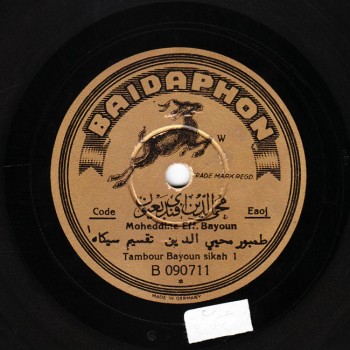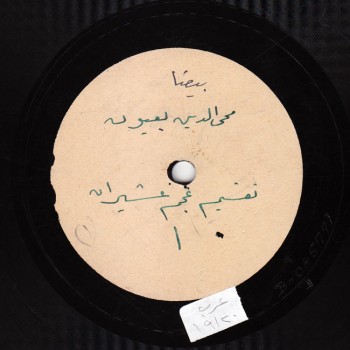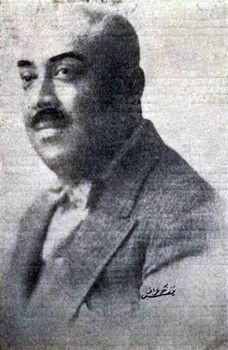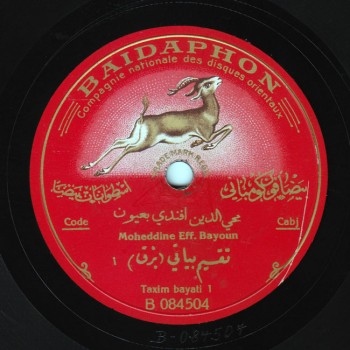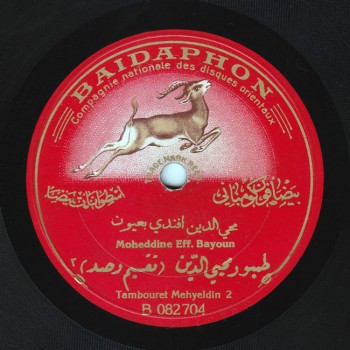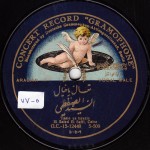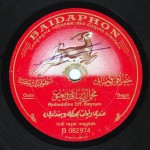The Arab Music Archiving and Research foundation (AMAR), in collaboration with the Sharjah Art Foundation (SAF), presents “Min al-Tārīkh”.
Our last episode of “Min al-Tārīkh” was dedicated to Muḥyiddīn Ba‘yūn’s singing.
Today’s episode is dedicated to Muḥyiddīn Ba‘yūn, the player of ṭanbūr baghdādī –known today as the buzuq.
The ṭanbūr was apparently played in many Levant countries, more so than in Egypt or Iraq. In fact, Mikhā’īl Mashāqa the author of “Al-risāla al-shahābiyya fī al-ṣinā‘a al-mūsīqiyya” used this string instrument as an example to support the rightness of his measuring theory and to refute his teacher Muḥammad al-‘Aṭṭār’s equal quartertones theory. Also, according to many 19th century travellers, the ‘ūd was more widely played in Egypt and in Iraq than it was in the Levant, unlike the ṭanbūr that was played more widely in the Levant than in Egypt or Iraq. Of course, this does not imply that the ‘ūd was not played in the Levant, or that the ṭanbūr was not played in Egypt and Iraq.
Yet, the first recordings made in the Levant do not reflect the words of those travellers: the ṭanbūr baghdādī, i.e. the buzuq, was barely heard before 1921 when Muḥyiddīn Ba‘yūn recorded it. All the previous recordings include takht with ‘ūd, kamān, qānūn, or kamān and qānūn without the ‘ūd. So, why wasn’t the ṭanbūr played in the recordings made in the Levant before 1921?
Let us listen to one of Abū Sa‘īd Muḥyiddīn Ba‘yūn’s recordings made in Cairo: a taqsīm sikāh recorded by Baidaphon –who had a monopoly over Muḥyiddīn’s recordings since that date– on one side of a 27cm record, # B-082703.
Note the presenter introducing Muḥyiddīn Ba‘yūn as the ṭanbūrī (ṭanbūr player).
(♩)
Muḥaddith mentioned that Muḥyiddīn sang while holding his ṭanbūr in his concerts. Yet this is not reflected in his recordings: in the only recording where he both sings and plays his ṭanbūr, these are done alternately, i.e. he does not accompany his singing instrumentally. Why? The weak recording technologies at the time –as described by Muḥyiddīn Ba‘yūn himself– may be the reason behind this.
(♩)
Many told about Muḥyiddīn’s playing and singing. In a Radio interview in Beirut in the 1950’s, Muḥammad al-Qaṣṣabjī said that he learned from Muḥyiddīn about a way to use the pick that was unknown to him, i.e. the Ibrahīmī rashsh,a method consisting in playing all the ṭanbūr’s chords together without producing a cacophony or any dissonance. Some veteran instrumentalists in the Levant whom we asked concerning this method attributed it to Abbasid Prince Ibrāhīm Ibn al-Mahdī, brother of Khalīfa Hārūn al-Rashīd and son of Khalīfa Muḥammad al- Mahdī. Yet their point finds no echo in any of the books about Ibrāhīm Ibn al-Mahdī.
Let us listen to a work of this type: a taqsīm to the bayyātī maqām included in the collection Abū Sa‘īd recorded in Beirut after his return from Cairo. The recording was made in 1924 on two sides of a 27cm record, # B-084504 and B-084505.
Note that the word“buzuq” was printed on the cover instead of “ṭanbūr”for the first time on this disc.
(♩)
Abū Sa‘īd travelled again to Cairo where he recorded in 1925. These recordings show, on the instrumental level, the mutual influence between Muḥyiddīn and Al-Qaṣṣabjī as to the movement of the pick and the structure of the phrase, as well as the Turkish influence that was already inspired by European Classical and Military music more than it was inspired by Arabic music: in Turkey, music was influenced by the above-mentioned European traditions since the beginning of the 19th century at least.
We will listen now to a piece where this influence is clear: a recording of taqsīm ‘ajam ‘ushayrān made by Baidaphon on two sides of a 27cm record, # B-085771 and B-085772.
(♩)
As mentioned in the previous episode, Abū Sa‘īd returned with an illness that also affected his throat. He stopped singing, and is said to have remained in a state of depression until he died.
Still, his listeners never let him down and insisted that he should go on making music even if his illness kept him from singing. So he gave many concerts with his ṭanbūr and recorded a number of discs following a recording technology that was recent at the time, i.e. electrical-power printed recording that allowed a purer sound.
Let us listen to one of these: the recording of a taqsīm to the sikāh made around 1928 by Baidaphon of course, on two sides of a 25cm record, # B-090711 and B-090712.
(♩)
Muḥyiddīn recorded a disc that is somewhat strange: it is his only instrumental recording of a piece that is not a taqsīm mursal. The first side is of samā‘ī bayyātī thaqīl, and the second side of a taqsīm ‘ala al-waḥda to the bamb and the bayyātī maqām. This disc has an equivalent recorded by Gramophone 4 or 5 years earlier, played by Sāmī al-Shawwā and his takht, yet with different taqsīm –of course– and a different performance of the samā‘ī. Which proves that Muḥyiddīn Ba‘yūn did not cut himself from his environment despite his illness and remained full of ambition and hope.
The recording was made within the same campaign, on two sides of a 25cm electrical-power printed record, # B-090886 and B-090887.
(♩)
We have reached the end of today’s episode of “Min al-Tārīkh”.
We will meet again in a new episode.
“Min al-Tārīkh” is brought to you by Mustafa Said.
- 221 – Zakariyya Ahmed – 12 (1/9/2022)
- 220 – Zakariyya Ahmed – 11 (1/9/2022)
- 219 – Zakariyya Ahmed – 10 (11/25/2021)
- 218 – Zakariyya Ahmed – 9 (10/26/2021)
- 217 – Zakariyya Ahmed – 8 (9/24/2021)
- 216 – Zakariyya Ahmed – 7 (9/4/2021)
- 215 – Zakariyya Ahmed – 6 (8/28/2021)
- 214 – Zakariyya Ahmed – 5 (8/6/2021)
- 213 – Zakariyya Ahmed – 4 (6/26/2021)
- 212 – Zakariyya Ahmed – 3 (5/27/2021)
- 211 – Zakariyya Ahmed – 2 (5/1/2021)
- 210 – Zakariyya Ahmed – 1 (4/28/2021)
- 209 – W-al-Lāhi lā astaṭī‘u ṣaddak 2 (4/6/2017)
- 208 – W-al-Lāhi lā astaṭī‘u ṣaddak 1 (3/30/2017)
- 207 – Bashraf qarah baṭāq 7 (3/23/2017)

